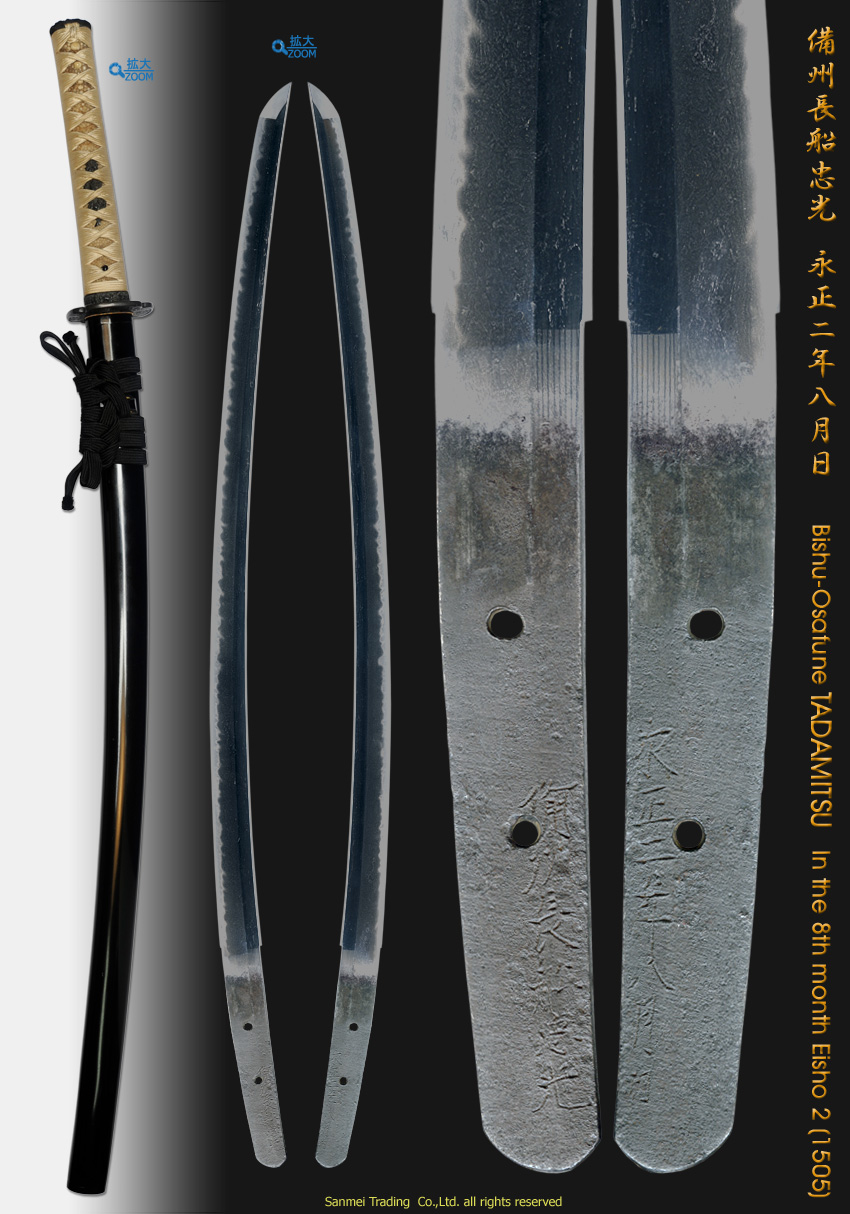with) Black Roiro style lacquered scabbard Uchikatana Koshirae
Length of cutting edge61.3cm Curvature2.3cm Width of base30.0mm Thickness of base7.4mm Width of Yokote18.7mm
Kitae(forging pattern) : Kitae-hada is vividly fine Ko-Itame (wooden grain) and mixing in with delicate Mokume-hada (burl grain) pattern. The steel of Hiraji surface is covered in sparkling ji-nie glitter that generates darkish minute Nie lines along wooden grain so called CHIKEI activity. The entire hiraji-surface is covered in speckled ji-nie that generates reflecting irregular whitish Utsuri effect vividly over the surface.
Hamon(tempering pattern) : Hamon forms Gunome pattern mixing with Clove (Choji) outline which is slanted generally. The heads of gunome radiate quenching effect frequently toward the Hiraji surface to generate some splash temper "Tobiyaki" and "Midare-Utsuri" that gives off diffused reflection with a mottled effect. The entire Kitae and Hamon is gaily decorated, grand sight.
Boshi (tip): The temper of tip is irregular to form "flames" then small circle turns back.
Nakago(tang) : UBU in original which shows "Machi-okuri" shorten the cutting edge in about seven-bu (2.0cm). An original clear file-mark shallow Katte-sagari (slanting left) with two mekugi-ana retaining holes and KURIJIRI (round heel shape) on bottom. The signature in front located on the shinogi-ji, clearly chiselled starting with the work of place Bishu Osafune 備州長船 and the smith name TADAMITSU 忠光. The reversed side is chiselled the date of year In the 8th month, the 2nd year of Eisho (1505) 永正二年八月日.
Powerful clans or generals from the disturbance period of Warring States Period to the Azuchi Momoyama state required the rich, massive volume and thick in kasane with high shinogi-ridge, with well-proportioned deep curve. Heavy on hand and solid construction, showing a brave Samurai spirit.
The latter half of Medieval Muromachi period, starting with The Onin War (応仁の乱 Onin no Ran) / (1467-77), the length and style of Japanese swords had changed - Eisho-Daiei(1504-27) it was generally 2.0 - 2.1 shaku(60-63cm) which was suitable for one-hand grip, Kyoroku-Tenbun(1528-40) it had become a bit longer to 2.2 shaku(66cm), then Ganki-Tenso(1570-91) it became further longer to 2.3 shaku or even more(70cm) and Nakago(tang) became getting longer accordingly which was designed in the style of both hands grip.
The founder of sword maker TADAMITSU 忠光 in Bizen is referred in Shouou period (1288-93) and the oldest existent Tanto has the date of year Teiji 3 (1364) during Nanbokucho period, then later generations showed the records of Ouei - Bunmei (1394-1486) in Muromachi period.
The subject sword, dated 1505 to understand that it would be produced by Hikobei TADAMITSU 彦兵衛忠光. He is a son of Goro-zaemon-no-jo NORIMITSU 五郎左衛門尉則光. His workmanship is as well as ones of Ukyo-no-suke KATSUMITSU 右京亮勝光, Sakyo-no-shin MUNEMITSU 左京進宗光 or Hikobei-no-jo SUKESADA 彦兵衛尉祐定 in the same age at Bizen. It has been said that No other sword makers can compare with him for the beauty of SUGUHA straight temper and the finest steel forging as well. This katana presents irregular quenced pattern of TADAMITSU that is quite differernt from ones of SUKESADA or KATSUMITSU in the same age and furthermore shows vividly fine steel unlike the other ordinary works of Bizen swords.
Black Roiro style lacquered scabbard Uchikatana Koshirae comprising : (click HERE for entire koshirae/HERE for higher resolution of each ornament)
- White rayskin Unohana (deutzia) color lozenge wrap hilt
- Peony/Leo design Menuki hilt ornament, Shakudo Yobori carving
- Peony design Shakudo Nanako-ji Takabori Gold drops inlay
- Chrysanthemum flower design Shakudo ground/Shakudo Fukurin rim
Old skilled polish/Condition scale: excellent - very good (using a scale of mint-excellent-very good-good-fair-poor).
reference :
Honma Junji/Sato Kanichi Nihonto Taikan Koto-hen #2 Otsuka kogeisha 1967
Osafune-cho-shi Hensan Iinkai Osafune Cho-shi 1998

